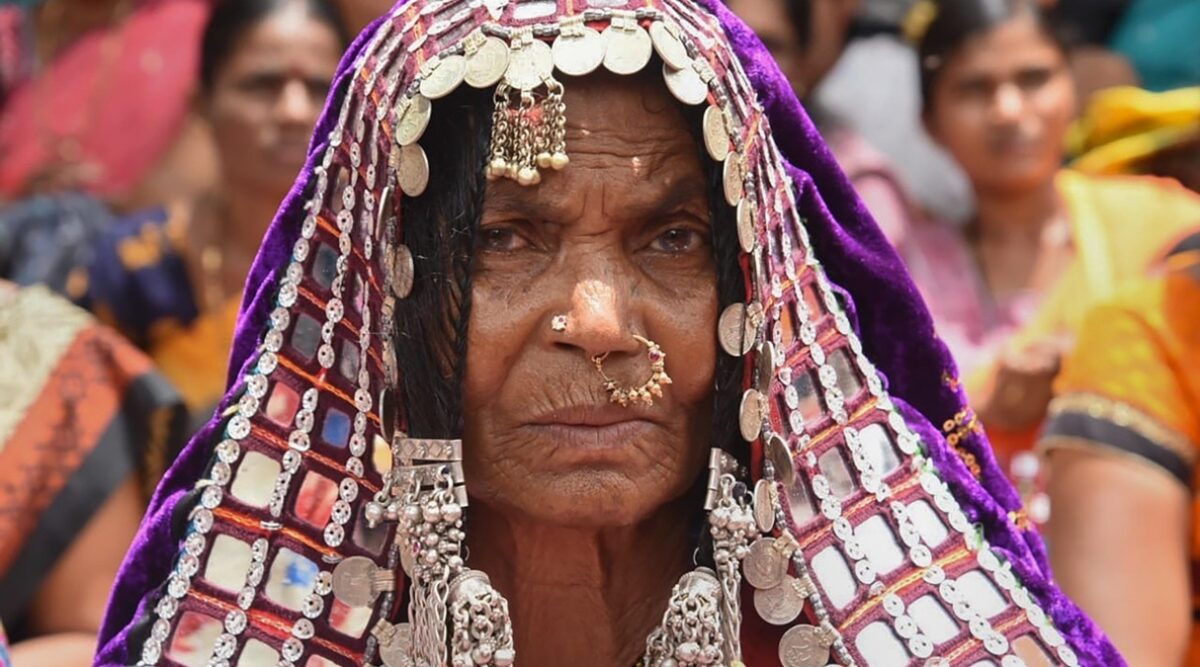Nestled within the vibrant tapestry of Indian textiles lies a hidden gem in danger of fading away – the Lambani Banjara folk embroidery. This intricate art form, adorning the ghagra cholis (skirt and blouses) of the Lambani (Banjara) community, tells a captivating story. It’s a story woven with threads of rich nomadic heritage, vibrant cultural identity, and the unwavering spirit of its women.
Table of Contents
A Journey Through Color and Stitch: The Lambani Banjara People and their Artistic Embroidery Legacy
The Lambani people, with a history stretching back over a millennium, have traditionally led a nomadic life. Their embroidery, known as “Lambani kasuti” (kasuti meaning embroidery), is a reflection of their unique cultural tapestry. Lambani women, the custodians of this art form, are skilled artisans who create breathtaking pieces using a dazzling array of colors and up to 23 distinct stitches. Each stitch, each meticulously constructed motif, becomes a visual narrative. These narratives, passed down through generations, speak of journeys undertaken, folklore cherished, and a deep connection with the natural world.
The vibrant colors used in Lambani kasuti are not merely aesthetic choices; they hold symbolic meaning. Rich blues and greens represent the vastness of the sky and the lushness of nature, their constant companions. Earthy tones like browns and ochres reflect the land they traversed, while fiery reds and oranges symbolize passion and strength. The geometric and floral motifs depict animals, celestial bodies, and everyday objects, each with its own story to tell.
However, the 21st century has cast a long shadow on this timeless tradition. The Lambani community’s traditional nomadic lifestyle is facing increasing challenges. Seasonal migrations in search of work disrupt the intergenerational transfer of knowledge, threatening the very foundation of Lambani kasuti. Moreover, the heavy, intricately embroidered garments are impractical for the demanding physical labor that many Lambani women now face.
Beyond Beauty: The Cultural Significance of a Disappearing Art
The decline of Lambani kasuti signifies more than just the loss of a beautiful art form. It represents the erosion of a cultural identity deeply intertwined with this embroidery. The vibrant colors and intricate patterns are not just decorative; they are a visual language that speaks of the Lambani people’s heritage and their ancestral lands. The loss of this art form would be akin to silencing a community’s voice, erasing a vital chapter in the rich tapestry of Indian culture.
Weaving a Brighter Future: Empowering Women, Reviving a Legacy
The need to revive Lambani kasuti goes beyond preserving a dying art form; it’s about empowering a community. Women are the heart and soul of this craft, and its revival can provide them with a source of sustainable income and a sense of self-sufficiency. Initiatives like Banjara Kasuti, founded in 2017, are leading the charge in this fight for revival.
These organizations create platforms for Lambani women to showcase their exquisite creations and connect with a wider market, ensuring fair wages and ethical production practices.
There are several ways we can all contribute to ensuring Lambani embroidery finds its rightful place in the contemporary world.
Supporting Artisans: Seek out brands and initiatives that directly collaborate with Lambani artisans. This ensures fair wages and ethical production practices, empowering the community while keeping the tradition alive.
Modern Adaptations: Embracing adaptations of traditional designs for contemporary clothing and accessories can broaden the appeal of Lambani kasuti. This doesn’t mean diluting the essence of the art form; it’s about finding innovative ways to integrate its beauty into modern lifestyles. Imagine a statement clutch adorned with intricate Lambani embroidery or a pair of jeans with a tastefully placed, modern interpretation of a traditional motif.
Promoting Cultural Awareness: Spreading awareness about the Lambani people and their embroidery is crucial. Educational programs in schools and universities, exhibitions showcasing the art form, and workshops conducted by Lambani artisans themselves can foster appreciation for this unique cultural expression.
The Digital Loom: Technology as a Tool for Revival
Technology can play a vital role in reviving Lambani kasuti. Online marketplaces and social media platforms can connect Lambani artisans with a global audience, providing them with a wider reach and increased opportunities. Additionally, documenting traditional stitching techniques and designs digitally can create a valuable archive for future generations, ensuring the knowledge is preserved even if the practice itself faces challenges.
Furthermore, promoting the use of eco-friendly dyes and fabrics alongside Lambani embroidery can make these products even more appealing to a contemporary, sustainability-conscious consumer.
Finally, government support through financial assistance, training programs, and marketing initiatives can significantly aid in the revival of Lambani kasuti.
By taking these steps, we can ensure that the threads of the Lambani Banjara folk embroidery continue to weave their magic, captivating not.
